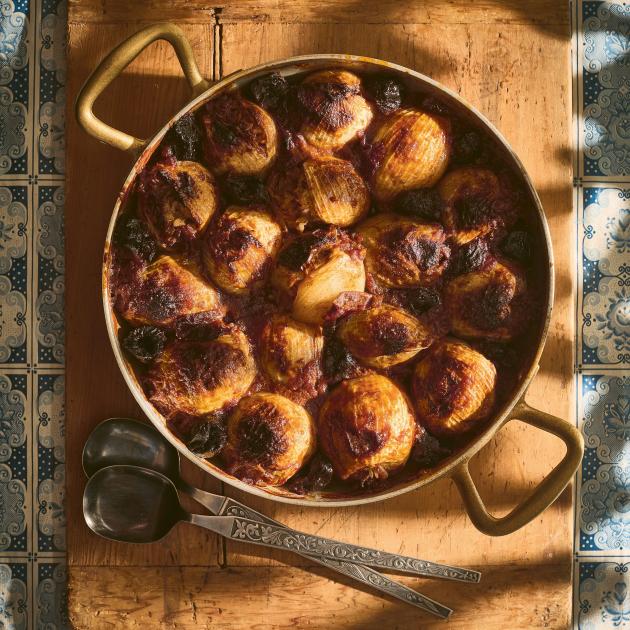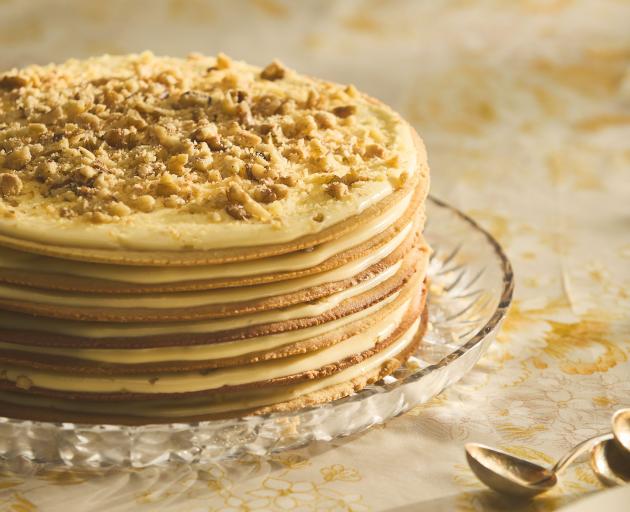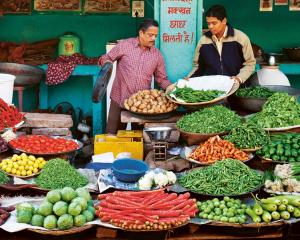
Whenever Anastasia Zolotarev eats a sour cherry, and closes her eyes she is back at her late babushka Lida’s dacha (summerhouse), where sour cherry trees flourish in the backyards of her old village in western Belarus.
It is where the now Sydney-based cook and former Masterchef Australia contestant was born.
‘‘Equally when I see, smell or taste sunflower oil, I am instantly transported to Ukraine - my dad’s home - where we lived for five years with my Ukrainian grandparents before we emigrated to Australia.’’
Back then, in the mid-1990s, these ingredients were not available in Australia so whenever she returned to Eastern Europe she would search them out.
Zolotarev was only 6 when she arrived in Brisbane and set about trying to become as ‘‘Australian’’ as possible. After about a year she had caught up on the language and the clothes.
‘‘But my school lunch box was different and it gave away that I was from a far off place few people had heard of.’’

Her mother would make her gourmet sandwiches with chicken pate and cucumber or a garlicky beetroot dip. She would scoff it quickly or not eat it all.
‘‘Now I want to celebrate the dishes Mum used to make, including her pate, with which my ‘‘hate-love’’ relationship has become one of complete love and appreciation.’’
She does not want her cookbook to be about the sadness of separation as when her family came out to Australia it was an adventure. But she does want it to inspire people to cook her family recipes and celebrate the food and flavours of the Ukraine, Belarus and beyond.
‘‘Food is grounding, it connects us to our culture and past through tradition, it moves with people, crosses borders and is ever evolving.’’
When she was researching the recipes for the book and asking family ‘‘how much flour/sugar/butter exactly’’ she was met with a simple answer ‘‘na glazok’’ - ‘‘by the eye’’.
‘‘I have written the recipes as if you were in the kitchen with me, my mum, my Babushka and others who have taught me so much about the food of my heritage. I give guidance and detail in the methods but there are so many variables in cooking, it’s for you to adjust as you feel, see and taste.’’
THE BOOK
Sour Cherries & Sun Flowers: Recipes From Eastern Europe And Beyond, by Anastasia Zolotarev. Photography by Karen Fisher and Anastasia Zolotarev.

Chicken and potato dill stew
Kurinoye ragu s kartofelem i ukropom
Thie stew is similar to chicken soup but slightly more substantial. It has few ingredients and dill is the hero.
The stew absorbs the liquid and develops flavour over time so you might need to add a bit more water if reheating over the following days.
Use starchy potatoes that break down to create an almost creamy sauce.
We typically enjoy this with friends in autumn or winter, served with plenty of fresh bread and vodka shots.
Serves 6-8
Ingredients
60g butter, plus an extra knob
1.2kg chicken cuts such as thighs, drumsticks and wings, or a 1-1.3kg whole chicken divided into portions
1 onion or leek, finely diced
2 carrots, thinly sliced into half-moons or quarters
1kg potatoes, peeled and chopped into smallish pieces
1 bay leaf
½ large bunch of dill, fronds chopped
salt and pepper
Method
Place a large stockpot over a medium-high heat and melt half the butter.
Roughly chop the larger pieces of chicken, like the thighs and breasts - the drumsticks and wings can go in whole.
Add the chicken pieces to the pot and cook on each side for 3-4 minutes or until the skin is golden (adjust the heat if it’s too hot).
Transfer the chicken to a plate.
Add the remaining butter and the onion.
Cook the onion for 7 minutes or until golden and translucent, adjusting the heat as needed.
Add the carrots and cook, stirring occasionally, for 5 minutes.
Return the chicken to the pot, along with the potatoes, bay leaf, a generous amount of salt and pepper and enough water to cover the ingredients (a bit less than three-quarters of the pot).
Cover with a lid, bring to a low-medium simmer and cook for 20 minutes, stirring occasionally.
Stir in the extra knob of butter and the dill.
Put the lid back on and let stand, off the heat, for 15 minutes.
Taste, adjust the seasoning and serve.

Stuffed sweet and sour onions in plum sauce
Farshirovanyy luk sslivovym sousom
Just like my babushka Liana, I love to add plums or prunes to my recipes and these onions are no exception.
You could add more plum jam for extra sweetness but I find this a nice balance of sweet and sour.
Serves 6–8 with sides
Ingredients
5 medium-large onions, peeled
1 large bunch of parsley, finely chopped
1 large carrot, grated
500g minced (ground) meat (beef, pork, lamb, or a mix)
210g jasmine rice
400ml passata
1 Tbsp sweet paprika
1 Tbsp plum jam (jelly)
250g pitted prunes
golden unrefined sunflower oil or other oil, for drizzling
salt and pepper
Method
Bring a full kettle of water to the boil.
For the onions, cut off the tips at both ends and from the root end, carve out the centre of the onion, so that the layers can come apart.
Next, stand the onion on its end, place the tip of your knife in the centre of the rings and slice down the length of one side, so that each layer is now ‘‘open’’.
Place into a large heatproof bowl and pour over the boiling water.
Cover with a lid and leave for 30-40 minutes.
Once the onions have softened, remove from the water.
Peel off each layer, trying to keep them intact, set aside the smaller centre layers for the filling.
Aim to have around 18 largish onion layers, or however many, once stuffed, will fit in your pan.
To make the filling, finely chop the reserved onion centres and place in a mixing bowl with the parsley, carrot, meat and rice.
Season with salt and pepper and mix thoroughly. Preheat the oven to 180°C fan/200°C
Add the passata, paprika, jam and 1 litre of water to a separate bowl.
Season and stir through.
Spread some of this sauce on the bottom of a large ovenproof casserole dish to cover it.
Fill each onion layer with about one heaped tablespoon of the filling and place into the dish, arranging each stuffed onion side by side.
Pour over the rest of the sauce, tuck the prunes between each stuffed onion, pushing them in slightly.
Drizzle with oil, then transfer to the oven and bake for 45 minutes or until the sauce has slightly reduced and the tops look darkened.
Check the rice and meat filling from an onion in the centre is cooked.
Serve and enjoy.

Honey, walnut and soured cream cake
Kutuzovsky tort
LOOKING back through the recipes from my dad’s Ukrainian babushka, this one in particular stood out. Zinaida was a celebrated cook and cake-maker.
Now when I look at her recipes I can see she would create magic with just a few basic ingredients, a reflection of the times and the way many people cooked.
Traditionally, Mum and Zina would use their hands to flatten the pastry layers — the result was a thickish pastry, so if you’d like to try that method do have a go. For ease and thinner layers, we often also roll it out now.
It’s best made the day before serving, so that the cake layers soften and are easy to slice.
Serves 8–10
For the pastry
240g unsalted butter at room temperature
200g brown sugar
4 Tbsp good-quality runny honey
2 eggs at room temperature
1 tsp bicarbonate of soda (baking soda)
2 tsp apple cider vinegar
600g plain (all-purpose) flour, sifted, plus extra for dusting
For the cream
200g unsalted butter, cubed and softened
210g caster (superfine) sugar
600ml soured cream at room temperature
6 Tbsp lemon juice (more or less, to taste)
150g walnuts, very finely chopped
Method
To make the pastry, put the butter and sugar in the bowl of a stand mixer with a whisk attachment, or add to a bowl and use an electric hand whisk.
Whisk on medium-high speed until well combined. Add the honey and eggs and whisk to combine.
Mix the bicarbonate of soda and vinegar in a small cup until fizzing, then pour this into the bowl and mix again.
Use a spatula to scrape down the sides.
Add the flour and whisk on a medium speed for a few minutes until everything comes together to form a sticky dough.
It should be quite heavy; add a little more flour if it’s a humid day.
Remove the dough from the bowl and use your hands to shape it into a log on a lightly floured surface.
Divide into seven roughly equal pieces.
Preheat the oven to 180°C fan/200°C.
Select a medium-sized round plate: this is your template for the pastry layers. Prepare seven pieces of baking paper, 2–3cm wider than the plate.
Coat the rolling pin in a little flour and roll out each piece of dough directly on the baking paper into very thin rounds (about 2mm).
Place the plate gently over the rolled-out dough sheets, one at a time, and use a knife to cut around the plate.
Use a fork to prick over the surface of each layer.
Reserve the offcuts from each layer, combine them and roll out into a small disc of the same thickness to use for making the crumbs later.
Transfer each piece of dough, still on its baking sheet, to a baking tray.
Cook each layer, one at a time, for about 8-10 minutes or until lightly golden – if using a fan oven, you can cook the layers in batches to speed things up.
Once ready, remove the pastry, with baking paper, from the hot tray and set aside to cool. I use a few trays interchangeably.
Once you have baked all the layers, place the disc made from the offcuts on some baking paper on a tray and cook for 8–10 minutes. Cool and then crush in a bowl to resemble toasted breadcrumbs. Set aside.
To make the cream, make sure you remove the soured cream from the refrigerator at least 45 minutes before using. Put the butter and sugar into the bowl of a stand mixer (or mix using an electric hand whisk). Whisk on low–medium speed until well combined and then add the soured cream and lemon juice, keeping the speed quite low so that the whisking doesn’t stiffen the cream. Continue to whisk for 1 minute and then remove and finish by hand, whisking until the cream is soft, creamy and the sugar has dissolved. If it’s too thick, adjust by adding more lemon juice or water.
To assemble the cake, place the first pastry layer on a cake stand or large flat plate that you’ll be serving the cake on. Spread a few heaped tablespoons of the cream over the entire surface. Sprinkle the cream with some of the finely chopped walnuts, then repeat the layering with the remaining pastry, cream and walnuts. Sprinkle the crushed pastry crumbs on top.
Keep in the refrigerator overnight, and take it out around 15 minutes before serving.
Tip: Experiment with flavours, like adding chopped pitted prunes to the cream. I also like to add a thin layer of homemade strawberry jam.











